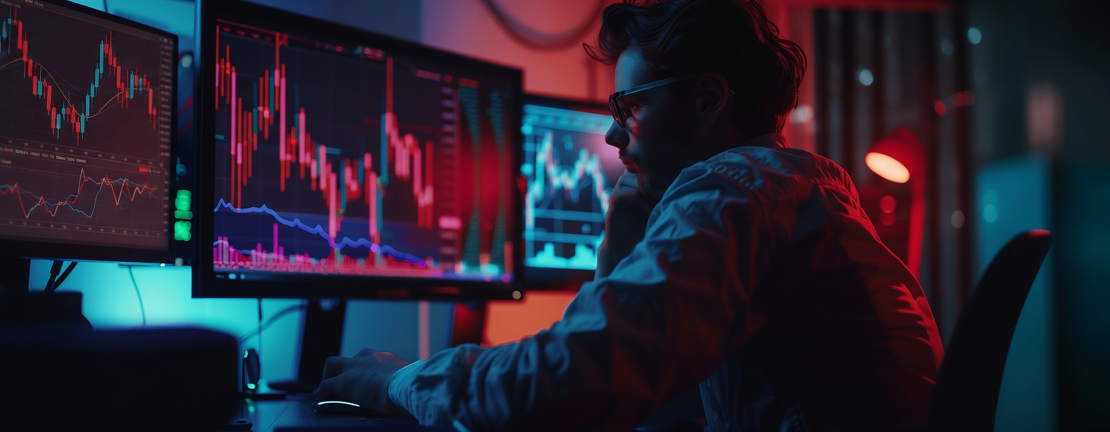Published 15 Oct 2025
How to Read Crypto Charts: A Beginner's Guide (No Experience Needed)

Crypto charts tell compelling stories about price movements that can make or break investment decisions. Beginners need to understand how to read these charts to direct their way through the volatile cryptocurrency market with confidence.
Crypto trading charts come in two main types: line charts and candlestick charts. Line charts are simple to understand, while candlestick charts give traders deeper insights into short-term price movements. Each candlestick shows a specific time period — a day or an hour. The colors are meaningful too — green means prices closed higher than opening, while red shows they closed lower.
Reading crypto charts goes beyond colors and shapes. Charts display time on the X-axis and asset prices on the Y-axis. On top of that, understanding candlesticks helps traders see opening and closing prices, along with highs and lows during each period.
Day traders should note that technical analysis helps understand market sentiment through patterns and trends in historical data. The main goal is to study cryptocurrency movements and predict future price action. This gives traders an edge in making smart decisions.
This piece breaks down everything about crypto charts in simple terms, perfect for anyone who hasn't looked at a financial chart before.
Types of Crypto Charts and How They Work
Cryptocurrency charts act as visual guides that show market movement. The digital world of crypto trading uses three main chart types. Each type gives traders different benefits based on what they want to analyze.
Line charts vs candlestick charts
Line charts show prices in the simplest way by tracking closing prices over time. This straightforward view helps traders spot market trends easily. Candlestick charts pack more detail and display four key price points: open, high, low, and close.
Japanese rice merchants created candlestick charts back in the 18th century. These charts are now the top choice among serious crypto traders. Each candlestick tells you exactly what happened to prices during a specific time period. The chart's rectangular "body" reveals the gap between opening and closing prices. Thin lines called "wicks" or "shadows" stretch out to mark the highest and lowest prices. Green or white candles mean prices went up, while red or black ones show prices dropped.
What bar charts show
Bar charts (or OHLC charts) bridge the gap between basic line charts and detailed candlestick charts. They display the same four price points as candlesticks for each period. The design uses a vertical line to show the price range. Small horizontal ticks stick out left for opening price and right for closing price.
Bars give you quick insights into price swings. Longer bars tell you prices moved more during that time. The colors work just like candlesticks — green means prices rose and red shows they fell.
When to use each chart type
Your trading goals should guide your chart choice:
-
Line charts — These work best for analyzing long-term trends and managing portfolios. Beginners love their simplicity. Support and resistance levels stand out more clearly on these charts.
-
Bar charts — These charts strike a perfect balance between detail and clarity. They shine in medium to long-term trading strategies that need complete price data without confusion.
-
Candlestick charts — Day traders find these charts invaluable. They excel at pattern spotting and reading market moods. The visual style helps traders make quick decisions based on price moves.
New crypto traders should start with line charts. This builds a strong foundation before they tackle the complex patterns in candlestick charts.

How to Read Candlestick Charts
Candlestick charts reveal significant price action stories that line charts cannot tell. Traders who understand these visual elements gain a substantial advantage in cryptocurrency markets.
What each candle represents
A candlestick captures four key price points within a specific timeframe — minutes, hours, or days. The price points include the opening price (start of period), closing price (end of period), high price (highest point), and low price (lowest point). Each candlestick shows the battle between buyers and sellers during that period and reveals who ended up in control.
Green vs red candles
The candlestick's color instantly shows price direction. Green (or sometimes white) candlesticks show bullish movement where prices closed higher than their opening. The body's bottom marks the opening price, while the top shows the closing price. Red (or black) candlesticks signal bearish movement where prices closed lower than their opening. These candles have the body's top representing the opening price and the bottom showing the closing price.
Wicks and what they tell you
Thin lines that extend from the candlestick's body are called wicks (or shadows). They provide valuable information about market volatility and sentiment. The upper wick reveals how high buyers pushed the price before sellers took control. The lower wick shows how far sellers drove the price down before buyers intervened.
Long wicks often show price rejection at certain levels. To cite an instance, a candlestick with a long upper wick suggests aggressive selling at higher prices. A long lower wick points to strong buying support.
How to read crypto candles for beginners
New crypto technical analysts should focus on these simple patterns:
- Doji candles have similar open and close prices that create a cross-like shape, suggesting market indecision
- Hammer patterns show small bodies with long lower wicks that might signal a bullish reversal in downtrends
- Long bodies point to strong directional pressure, while short bodies suggest minimal price movement or indecision
Becoming skilled at candlestick interpretation takes practice. These fundamentals provide solid groundwork to advance your crypto chart analysis skills.

Recognizing Patterns and Market Signals
Pattern recognition opens up a whole new dimension beyond basic candlesticks. Crypto traders with years of experience look for these distinct formations to predict market moves.
Bullish and bearish candlestick patterns
Chart patterns show how market psychology works through specific candlestick arrangements. Bullish patterns point to possible price increases. A bullish engulfing pattern happens when a green candle fully covers the previous red one, which shows buyers have taken control from sellers. The hammer pattern comes with a small body and long lower wick. It usually shows up after a downtrend and suggests strong buyer interest.
Bearish patterns signal potential price drops. You'll see a bearish engulfing pattern when a red candle swallows up a previous green one — a clear sign that sellers are back in charge.
The hanging man looks like a hammer but appears at the peak of an uptrend. It often warns of upcoming downward moves. Traders also watch for doji stars that show market uncertainty and evening/morning stars that signal trend reversals with three candles.
Support and resistance levels
Support and resistance are the foundations of technical analysis. Support emerges at price levels where buyers consistently overpower sellers. This creates a price floor. Resistance shows up where selling pressure stops upward price movement, acting like a ceiling.
These levels stick because traders remember past price points and react to them. A support or resistance level grows stronger each time the price tests it without breaking through. Bitcoin's price at round numbers like $30,000 often creates these psychological barriers.
Trendlines and price channels
Trendlines help traders see market direction by connecting price points. An uptrend line links higher lows and serves as moving support. A downtrend line connects lower highs and works as moving resistance. Broken trendlines often mean the trend might change.
Price channels appear when two parallel trendlines contain price movement — one touching the highs and another touching the lows. These channels create clear opportunities. Many traders buy near channel support and sell close to resistance until prices break out.
How to read crypto charts for day trading
Day traders focus on clear breakouts from established patterns and key levels. Triangle patterns — ascending, descending, or symmetrical — offer valuable trading signals. The head-and-shoulders pattern shows three peaks with the middle one highest. Prices breaking below the "neckline" usually signal a downward reversal.
The best day traders check patterns across different timeframes. Patterns that show up on multiple timeframes tend to work better. Strong volume during breakouts helps confirm that a pattern is valid.

Using Technical Indicators Effectively
Technical indicators help lift crypto chart analysis beyond simple patterns and provide statistical measures that help traders make informed decisions. Traders can get precise entry and exit signals if they understand these tools properly.
Moving averages and crossovers
Moving averages help smooth out price fluctuations by calculating average prices over specific periods. The Simple Moving Average (SMA) gives equal weight to all prices and works well to identify long-term trends. The Exponential Moving Average (EMA) puts more emphasis on recent prices and responds quickly to current trends. A "Golden Cross" forms when a shorter MA moves above a longer one (like the 50-day above the 200-day), which signals a potential bullish trend. The opposite scenario, known as a "Death Cross," happens when the shorter MA drops below the longer one, showing a possible bearish trend.
RSI and overbought/oversold zones
The Relative Strength Index (RSI) measures momentum on a scale from 0 to 100. Readings above 70 typically show overbought conditions, while readings below 30 point to oversold conditions. RSI stays above 30 and regularly hits 70 during strong uptrends. During downtrends, it rarely goes above 70. New traders should wait for the RSI to cross back below 70 or above 30 to confirm a momentum change, rather than buying or selling immediately when RSI enters these zones.
MACD and momentum shifts
Moving Average Convergence Divergence (MACD) combines the MACD line (difference between 12-day and 26-day EMAs), the signal line (9-day EMA of MACD), and a histogram that shows their difference. Bullish signals appear when the MACD crosses above the signal line. Bearish signals emerge when it drops below. Traders can see momentum strength through the histogram — larger bars mean stronger momentum, while shrinking bars suggest weakening trends.
Bollinger Bands and volatility
Bollinger Bands use three lines: a middle 20-day SMA with upper and lower bands typically set two standard deviations away. High volatility makes the bands wider, while low volatility narrows them, which might signal an upcoming breakout. Overbought conditions may appear when prices touch or exceed the upper band. Oversold conditions might show up when prices reach the lower band.
Volume analysis and its role
Volume shows trading activity and confirms price movements. Strong buying interest and trend continuation often come with high volume during price increases. Weakening momentum and potential reversal might occur when prices rise but volume declines. Market reactions to news events often create volume spikes. New crypto traders should combine volume with other indicators to strengthen trading signals. Pattern validity gets more confirmation when higher volume accompanies breakouts.
Conclusion
The ability to read crypto charts sets apart successful traders from those who make uninformed decisions. Traders gain powerful analytical tools when they learn simple chart types, patterns, and indicators.
Traders who become skilled at reading candlestick charts understand the ongoing battle between buyers and sellers at specific intervals. These visual cues tell detailed stories about market psychology that line charts simply can't show.
Chart patterns like support and resistance levels help traders spot potential price floors and ceilings. Trendlines and price channels boost trading strategies by showing market direction and creating opportunities within set ranges.
Technical indicators make analysis stronger beyond simple patterns. Moving averages, RSI, MACD, Bollinger Bands, and volume analysis offer statistical measures that confirm trends and signal possible reversals. But no single indicator works perfectly, so combining multiple tools leads to more accurate predictions.
Chart reading takes practice and patience. New traders should focus on simple chart types and candlestick patterns before moving to complex indicators. Skills built through steady chart analysis will improve trading decisions by a lot in any market condition.
Charts show real market sentiment and behavior. The best results come from mixing technical analysis with fundamental factors to create a detailed trading approach. This balanced method helps traders direct themselves through volatile crypto markets with confidence and precision.

 Get RateX Pro
Get RateX Pro

 06 Jun 2024
06 Jun 2024


